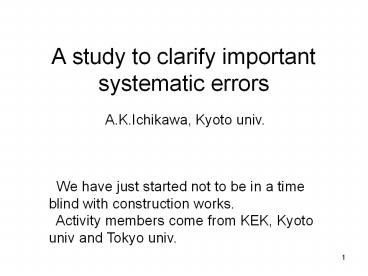A study to clarify important systematic errors
Title:
A study to clarify important systematic errors
Description:
We have just started not to be in a time blind with ... Systematic shifts on (sin22q23,Dm232) are evaluated with following ... MINOS 90% 4. This was a very ... –
Number of Views:30
Avg rating:3.0/5.0
Title: A study to clarify important systematic errors
1
A study to clarify important systematic errors
- A.K.Ichikawa, Kyoto univ.
We have just started not to be in a time blind
with construction works. Activity members come
from KEK, Kyoto univ and Tokyo univ.
2
Hiraide study in 2004http//www-he.scphys.kyoto-u
.ac.jp/member/hiraide/t2k/index.html
- Systematic shifts on (sin22q23,Dm232) are
evaluated with following systematic errors. - Flux normalization uncertainty (10)
- Non-QE ratio uncertainty (20)
- Energy scale uncertainty (4)
- Spectrum shape uncertainty (FLUKA/MARS)
- Spectrum width uncertainty (10)
3
Systematic shift
K.Hiraide
OA2.5deg
d(sin2 2q)
d(Dm2)
MINOS 90
shape
nqe
esk
width
width
norm
stat.
stat.
esk
norm
shape
nqe
Various systematic shifts are shown as a function
of true Dm2. Dashed lines indicate the size of
statistical error.
4
- This was a very instructive study. Direct
reduction of above systematic errors is very
important. - Indirect reduction of systematic errors by
cancellation btw. near and far observation is not
evaluated. - Near to Far Extrapolation method should be
studied. A new method may be useful if that is
found to be robust against systematic
uncertainty. - Default Far/Near ratio
- Matrix in (Enfar, Ennear) plane.
- Using parents(p,K) (p,q) distribution
- Some of the systematic errors is not evaluated.
(e.g. beam related ones.)
5
Cancellation of syst error on N11exp
N11exp(f)
NSKMC(f)
?NKTMC(f)
From K2K
6
Contribution of syst. errors on spectrum
From K2K
Spec.
nQE/QE
Spec.nQE/QE
Total
SK Escale
eSK
F/N
7
K2K-II ne appearance searchError on backgrounds
from nm
NC1p0/CC ratio 6,-7
NC/CC ratio(non-NC1p0) -3
p0 energy spectrum -8
coherent p0 model 3,-10
p0 mass cut 19,-17
water properties -6
neutrino flux at SK -6
non-QE/QE ratio -1
detector efficiency -6
single electron selection 7, -8
Total 39,-24
Super-K intrinsic
8
Short term goal of this study
- Find the best near to far extrapolation method
- The best one would varies depending on statistics
and information from NA61 and ND measurements. - Can ND mesurements constrain hadron production
uncertainty when there is uncertainty on netrino
interaction? - Make oscillation analysis tool for T2K based on
the K2K method. - See next slide.
- Clarify the importance of following systematic
errors as a function of statistics - Hadron production
- Compare GFLUKA, MARS and FLUKA2007
- Getting reasonable error matrix on flux by
assuming reasonable uncertainty in (p,q)
distribution - After NA61 results come, this will be replaced.
- Beamline origin (misalignment etc.)
- Neutrino interaction
- Energy dependent non-QE/CCQE ratio, NC/CC ratio
- Super-K intrinsic
- energy scale and normalization (comes from FV,
PID etc.) - For ne appearance, statistical and Super-K
intrinsic error would be dominant. Still update
of p.7 table with T2K off-axis flux is important
to confirm this.
9
Likelihood
From K2K
Normalization term
Shape term for FCFV 1Rm
Systematic parameter constraint term
10
T2K Near to Far extrapolation Matrix
En(Super-K)
Robustness against the hadron production
uncertainty will be checked. En(Super-K) v.s.
En(on-axis) will be made, too.
Very Preliminary
En(Off-axis ND280)
K.Sakashita































